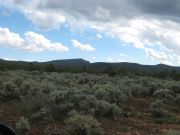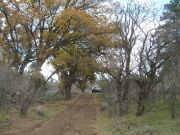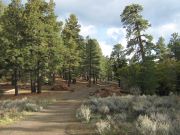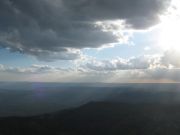
The Mountains of Arizona
• www.surgent.net
|
| Mount Logan |
• Uinkaret Plateau, Arizona Strip • Highpoint: Sawmill Mountains • Mount Logan Wilderness, Mohave County |
|
Date: October 13, 2013
• Elevation: 7,866 feet
• Prominence: 1,226 feet
• Distance: 5 miles
• Time: 2 hours and 15 minutes
• Gain: 700 feet
• Conditions: Cold with clouds and very stiff winds
• Teammates: Scott Casterlin
Scott Casterlin and I were on a weekend drive through the Arizona Strip, having arrived yesterday and already hiked two peaks, with Mount Dellenbaugh being the most recent from this morning. We were finished with that hike and back to Scott's vehicle around noon, so we started the slow drive east toward our next objective, Mount Logan, located about 65 miles north and east of Mount Dellenbaugh.
The drive north from Mount Dellenbaugh to the junctions of Roads 103 and 5 went well, but we took the road slow, taking about two hours to cover the 40 miles. The weather had become unsettled, with brisk wind and disorganized storm clouds, including a few that were dropping virga. However, we never experienced direct rain, but were aware that any moisture could make these roads challenging to drive. To the south, however, the sky was clear, so it was evident we were on the boundary of this fast-moving system.
Back on Road 5, we turned south and drove a dozen miles into the townsite of Mount Trumbull, also called Bundyville. This was the only actual town that survived for any length of time on the Strip, with a population as high as 300 in the 1920-40s. The last permanent resident left in 1968. Today, a schoolhouse is the only structure that suggests the existence of the old town. However, this schoolhouse is a rebuilt one, after the original was burned about 30 years ago. Surrounding this schoolhouse are a few scattered ranches, and it would appear they are occupied and active, although it begs the question how permanent this population may be.
At the schoolhouse, we turned left (still on Road 5) and followed the road steeply up through a weakness in the Hurricane Cliffs, a solid wall of cliffs about 1,000 feet high that run about 30 miles north-south. The road is well-built, but it gets narrow for about a half-mile where it traverses across the rocky cliffs directly. Soon, we were atop the cliffs, now on higher plateau with more abundant forests and colder temperatures. Mount Trumbull (the mountain) was directly ahead, and we were at its base near the Nixon Ranger Station a little before 3 p.m. Along the way, we had good views of Mount Logan to the south. We also had a quick chat with a National Park Ranger out doing his rounds.
At the Nixon Ranger Station complex, we turned south onto BLM-1044 (a sign saying that Mount Logan is 7 miles farther). We drove up BLM-1044 for about 2 miles through a section of stumps and also a small but interesting bed of lava. We stayed right at a junction (still on 1044) and rumbled forward, the road a little rough but not too bad. We came to a Y-junction about 4 miles from the Nixon Ranger Station. This junction was not on the map, but we could infer our position easily. We were at 7,160 feet elevation and about 2.5 road miles from the peak. The other branch of the junction led down into a meadow lined with aspen, yellow and orange with fall colors. We were beneath large oaks and sycamores, also featuring fall colors.
We decided to drive back about a half-mile to a camping pullout. It was chilly, breezy and gloomy. The plan was to camp here the night, then hike Mount Logan the next morning. I don't think either of us were enthused about this camping spot. We stood around for about 10 minutes and I proposed that we hike the peak now, and Scott immediately agreed. There was no discussion. We drove back to that Y-junction, locked everything up and immediately started walking, the time 3:30 p.m.
The route was simple: we followed the road (called BLM-1064 after one subsequent junction) to its end just a half-mile east of the summit, from which a foot-path works through the ponderosa to the summit. We were looking at about a 5-mile round-trip hike with about 700 feet of gain. We moved quickly and covered the one-way to the summit in a shade over an hour. The hike itself was not terribly interesting. We saw cattle and also some deer. We were at the summit about 4:45 p.m., the sun already low in the west.
The real treat of this hike is the view down into Hell's Hole, a huge amphitheater of rock forming a headwall of a side canyon that leads south to the Grand Canyon. The view was magnificent, of course. South we could see more canyons heading toward the Grand Canyon, while north we had a view of the plateau, its boundaries sharply defined where they "end" at the various cliffs. Way north toward St. George were more abundant storm clouds.
We spent about 10 minutes here. The wind was moderately breezy but it was chilly. The clouds were still around us, and we could see Mount Dellenbaugh enveloped in these clouds. There were enough breaks to make a pretty sunset. We found the highpoint, tagged it, then started down. We were back to Scott's vehicle at 5:45 p.m. It was getting dusky by now. We piled in and drove back down to the Nixon Ranger Station, by which time it was dark. We planned to camp at the trailhead of Mount Trumbull for no other reason than it was flat. In the dark, I pitched my tent, then we both sat in the front of the vehicle and waited out a brief rain shower. It wasn't even 7 p.m.
We were done with our objectives here on the Strip, and the rainy, cold weather was dampening our spirits. We had no idea how long or how severe the rain may be, and the thought of muddy, potentially impassable roads was a reasonable concern. This particular camping spot held no value to us, so after some brief discussion, we decided to bail. I took down the tent, loaded up the vehicle, and we drove 60 miles back to pavement and civilization near Fredonia, Arizona. There was nothing open in Fredonia so we continued north to Kanab, Utah, where we got gas and snacks. By now, the clouds had moved on, but it was very chilly.
We drove east on US-89 for about 15 miles, then bush-camped in the high desert in a glade of pinon trees. I slept well, but the next morning, everything was covered in frost. After breaking down camp, we started again, driving south via House Rocks Canyon back into Arizona, then a stop at Marble Canyon and the Navajo Bridge. We stopped again for lunch in Flagstaff, and we were back in Scottsdale by 4 p.m., where I unloaded my stuff, shook hands with Scott and thanked him for all the driving and camaraderie up on the Strip.
I was beat and very smelly, but happy to be home. I was also pleased to finally visit those way-remote summits up there on the Arizona Strip, and I assure you I will go back.
|
|










